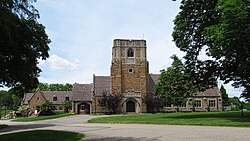| Homewood Cemetery | |
|---|---|
 Homewood Cemetery chapel | |
 Interactive map of Homewood Cemetery | |
| Details | |
| Established | 1878 |
| Location | |
| Country | United States |
| Coordinates | 40°26′28″N79°54′32″W / 40.441°N 79.909°W |
| Type | Urban |
| Size | 650-acre (2.6 km2) |
| No. of graves | 77,000+ |
| Website | Official website |
| Find a Grave | Homewood Cemetery |
Homewood Cemetery is a historic urban cemetery [1] in Pittsburgh, Pennsylvania, United States. It is located in Point Breeze and is bordered by Frick Park, the neighborhood of Squirrel Hill, and the smaller Smithfield Cemetery. [2]
Contents
- Notable interments
- Business leaders
- Political leaders
- Military leaders
- Artists and musicians
- Science and medicine
- Sports figures
- Others
- Gallery
- See also
- References
- External links

It was established in 1878 from William Wilkins' 650-acre (2.6 km2) estate, Homewood. [3]

